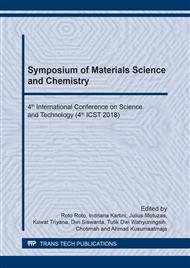[1]
Chauhan, P., Chauhan, R. P., & Gupta, M., Estimation of naturally occurring radionuclides in fertilizers using gamma spectrometry and elemental analysis by XRF and XRD techniques. Microchemical Journal, 106, (2013) 73-78.
DOI: 10.1016/j.microc.2012.05.007
Google Scholar
[2]
Khater, A. E. M., AL-Sewaidan, H. A., Radiation exposure due to agricultural uses of phosphate fertilizer. Journals of Radiation Measurement, (2008).
DOI: 10.1016/j.radmeas.2008.04.084
Google Scholar
[3]
Jones US. 1982. Fertilizer and soil fertility. Reston Pub.Co.Inc. Reston-Virginia: A Prentice-Hall Company.
Google Scholar
[4]
Roni, N. G. K. N. M., Witariadi., N. N. Candraasih. K., & N. W. Siti., Pemanfaatan bakteri pelarut fosfat untuk meningkatkan produktivitas kudzu tropika (Pueraria Phaseoloides Benth. Pastura, Vol. 3, No. 1, (2006) 13-16.
Google Scholar
[5]
El-Taher, A., & Althoyaib, S. S., Natural radioactivity levels and heavy metals in chemical and organic fertilizer used in the Kingdom of Saudi Arabia. Applied Radiation and Isotopes, 70, (2012), 290-295.
DOI: 10.1016/j.apradiso.2011.08.010
Google Scholar
[6]
Lambert, R., Grant, C., Sauve, C., Cadmium and zinc in soil solution extracts following the application of phosphate fertilizer. Sci. Total Environ, 378, (2007) 293-305.
DOI: 10.1016/j.scitotenv.2007.02.008
Google Scholar
[7]
Udiyani, PM., Sebaran zat radioaktif di lingkungan dan hubungannya dengan prilaku petani dalam pengguna pupuk (disertasi). Bogor: Institut Pertanian Bogor, Program Pascasarjana, (2002).
DOI: 10.19081/jpsl.5.2.180
Google Scholar
[8]
Roselli, C., Desideri, D., Meli, M.A., & Feduzi, L., Sequential extraction for the leachability evaluation of phosphate fertilizers. Microchemical Journal, 95, (2010) 373-376.
DOI: 10.1016/j.microc.2010.02.020
Google Scholar
[9]
Indri Setiani., Mohammad Munir., K. Sofian Firdausi., Penentuan konsentrasi aktivitas uranium dari industri fosfat menggunakan detektor ZnS. Berkala Fisika, Vol. 9, No.2, (2006) 290-295.
Google Scholar
[10]
Rehman, S., Imtiaz, N., Faheem, M., & Matiullah., Determination of U-238 contents in ore samples using CR-39 based radon dosimeter disequilibrium case. Radiation Measurement, 41, (2006) 471-476.
DOI: 10.1016/j.radmeas.2005.10.002
Google Scholar
[11]
Uosif, M. A. M., Mostafa, A. M. A., Elsaman, Reda., & Moustafa, El-Sayed., Natural activity levels and radiological hazards indices of chemical fertilizers commonly used in Upper Egypt. Journal of Radiation Research and Applied Science, (2014).
DOI: 10.1016/j.jrras.2014.07.006
Google Scholar
[12]
Camacho, A., Devesa, R., Valles. I., Serrano, I., Soler, I., Blazquez, S., at al., Distribution of uranium isotopes in surface water of the lobregat river basin (Notheast Spain). Journal of Environmental Radioactivity, Vol 101, (2010) 1048-1054.
DOI: 10.1016/j.jenvrad.2010.08.005
Google Scholar
[13]
Mohanty, A. S., Segupta, D., Das, S. K., Saha, S. K., & Van, K. V., Natural radioactivity and radiation exposure in the high background area at Chhatarpur beach placer deposit of Orissa, India. Journals of Environmental Radioactivity, 75, (2004) 15-33.
DOI: 10.1016/j.jenvrad.2003.09.004
Google Scholar
[14]
Alharby, W. R., Natural Radioactivity and dose assessment for brand of chemical and organic fertilizers used in Saudi Arabia. Journal of Modern Physics.Vol 4. (2013) 344-348.
DOI: 10.4236/jmp.2013.43047
Google Scholar
[15]
UNSCEAR., United Nations Scientific Committee on the Effect of Atomic Radiation. Exposure from natural radiation sources. New York; United Nation, (2000).
DOI: 10.18356/fa7a3c47-en
Google Scholar
[16]
N.K. Ahmed and A. M. El-Arabi., Natural Radioactivity in Farm Soil and Phosphate Fertilizer and Its Environmental Implication In Qena Governorate, Upper Egypt. Journal of Environmental Radioactivity. Vol. 84. No. 1, (2005).
DOI: 10.1016/j.jenvrad.2005.04.007
Google Scholar
[17]
C. H. Saueia, B. P. Mazzilli, and D. I. T. Favaro., Natural Radioactivity in Phosphogypsum and Fertilizer in Brazil. Journal of Radioanalytical and Nuclear Chemistry. Vol. 264. No. 2, (2005).
Google Scholar
[18]
N.N. Jibiril and K.P Fasae., Activity Concentration of 226Ra, 232Th and 40K in Brands of Fertilizer Used in Nigeria. Radiation Protection Dosimetry. Vol. 148. No.1, (2012).
DOI: 10.1093/rpd/ncq589
Google Scholar
[19]
ICRP., International Commission on Radiological Protection the 1990-1991 Recommendation of the International Commission on Radiological Protection, Publication 60. Pergamon. Oxford, (1990).
DOI: 10.1016/0306-4549(92)90053-e
Google Scholar


